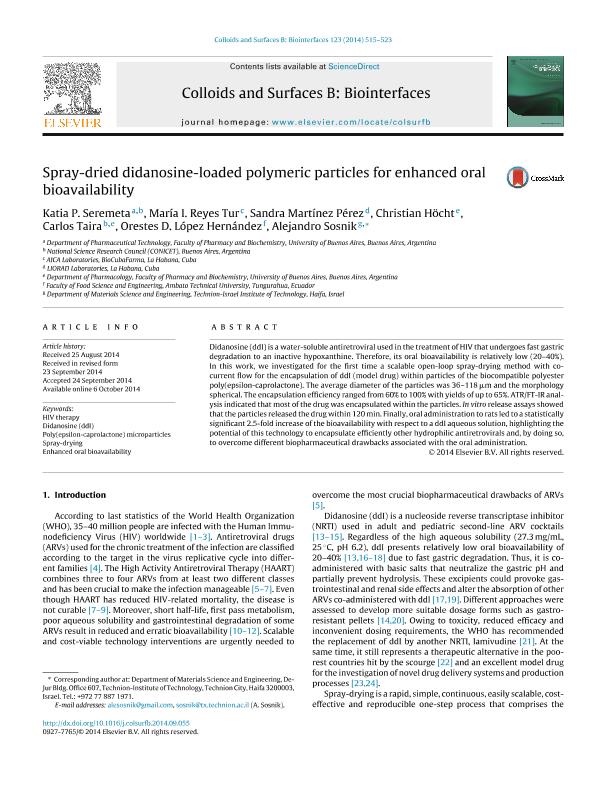Artículo
Spray-dried didanosine-loaded polymeric particles for enhanced oral bioavailability
Seremeta, Katia Pamela ; Reyes Tur, María I.; Martínez Pérez, Sandra; Höcht, Christian; Taira, Carlos Alberto
; Reyes Tur, María I.; Martínez Pérez, Sandra; Höcht, Christian; Taira, Carlos Alberto ; López Hernández, Orestes D.; Sosnik, Alejandro Dario
; López Hernández, Orestes D.; Sosnik, Alejandro Dario
 ; Reyes Tur, María I.; Martínez Pérez, Sandra; Höcht, Christian; Taira, Carlos Alberto
; Reyes Tur, María I.; Martínez Pérez, Sandra; Höcht, Christian; Taira, Carlos Alberto ; López Hernández, Orestes D.; Sosnik, Alejandro Dario
; López Hernández, Orestes D.; Sosnik, Alejandro Dario
Fecha de publicación:
11/2014
Editorial:
Elsevier Science
Revista:
Colloids and Surfaces B: Biointerfaces
ISSN:
0927-7765
Idioma:
Inglés
Tipo de recurso:
Artículo publicado
Clasificación temática:
Resumen
Didanosine (ddI) is a water-soluble antiretroviral used in the treatment of HIV that undergoes fast gastric degradation to an inactive hypoxanthine. Therefore, its oral bioavailability is relatively low (20–40%). In this work, we investigated for the first time a scalable open-loop spray-drying method with co-current flow for the encapsulation of ddI (model drug) within particles of the biocompatible polyester poly(epsilon-caprolactone). The average diameter of the particles was 36–118 μm and the morphology spherical. The encapsulation efficiency ranged from 60% to 100% with yields of up to 65%. ATR/FT-IR analysis indicated that most of the drug was encapsulated within the particles. In vitro release assays showed that the particles released the drug within 120 min. Finally, oral administration to rats led to a statistically significant 2.5-fold increase of the bioavailability with respect to a ddI aqueous solution, highlighting the potential of this technology to encapsulate efficiently other hydrophilic antiretrovirals and, by doing so, to overcome different biopharmaceutical drawbacks associated with the oral administration.
Archivos asociados
Licencia
Identificadores
Colecciones
Articulos(OCA HOUSSAY)
Articulos de OFICINA DE COORDINACION ADMINISTRATIVA HOUSSAY
Articulos de OFICINA DE COORDINACION ADMINISTRATIVA HOUSSAY
Citación
Seremeta, Katia Pamela; Reyes Tur, María I.; Martínez Pérez, Sandra; Höcht, Christian; Taira, Carlos Alberto; et al.; Spray-dried didanosine-loaded polymeric particles for enhanced oral bioavailability; Elsevier Science; Colloids and Surfaces B: Biointerfaces; 123; 11-2014; 515-523
Compartir
Altmétricas



